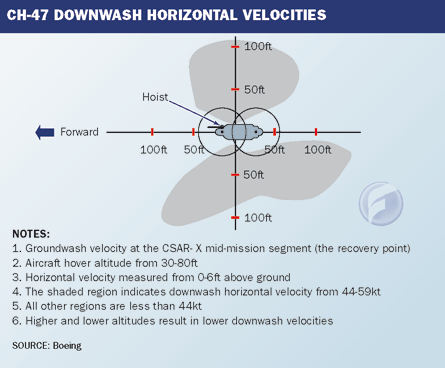The Boeing HH-47 Chinook is a large tandem-rotor helicopter, and, as such, has a larger surface area than a single-rotor aircraft to distribute the force generated by its spinning blades.
That is the one fact agreed by all sides in the latest bizarre controversy to hit the US Air Force's CSAR-X combat search-and-rescue helicopter competition. Boeing won the $11 billion contract last November with its HH-47 Chinook, only to have the decision overturned a few months later.
As losing competitors Lockheed Martin and Sikorsky seek to overturn a second downselect process, a new dispute is raging over a key issue: does the HH-47's tandem-rotor configuration generate more downwash wind velocity than the USAF's stated 65kt (120km/h) limit, making it impossible for rescue crews to do their jobs saving downed pilots?

For J Gordon Leishman, an aerospace engineer at the University of Maryland, the answer is conclusively "yes". As part of his research into rotorcraft "brownout" conditions Leishman has developed a mathematical model for predicting wind velocities caused by rotor downwash, and according to this the Chinook should generate pockets of downwash velocity well in excess of 65kt.
Leishman's research corresponds to public complaints made in recent weeks by the Lockheed Martin/AgustaWestland team and Sikorsky, respectively offering CSAR variants of the US101 and S-92.
After losing the original competition, both competitors won appeals based on the method the USAF used for evaluating lifecycle maintenance costs for each aircraft. They are now protesting the air force's terms for the new competition, which allow them to make only slight adjustments to their offers rather than restart from scratch.
In addition to using the downwash debate, officials from both companies also allege that the HH-47 fails to measure up to other air force requirements for the CSAR-X fleet, such as a 3h deadline for reassembling its rotorhubs.
Boeing earlier this month went on the offensive to defend the Chinook as the best aircraft for the search-and-rescue mission, including statements that the HH-47 in fact has the lowest disc-loading of the three candidate aircraft, so must produce the least amount of downwash velocity. It estimates that this should be a maximum of 59kt in the zone beneath the centre of the fuselage where the rotors overlap, but just 30-40kt in other areas, such as where the rescue hoist is located on the forward fuselage (Flight International, 17-23 July).
Leishman disputes Boeing's basic methodology and its final results. Average downwash velocities for single rotor helicopters can be calculated easily by measuring the square root of the aircraft's disc loading. The S-92 and US101 have loadings about 20% and 30% higher, respectively, than the HH-47, and therefore downwash velocities 10-15% higher.
But Leishman says: "These are average velocities and discount the always present non-uniformities of the downwash below the rotor. Remember that the CH-47 is a tandem overlapping rotor design this means that the downwash below the overlapped region [which is a significant fraction of the total rotor disc area] will be about 30-40% higher than the downwash predicted on the basis of disc loading arguments alone." Leishman based his estimates for the Chinook's wind velocities on data taken from a 1974 study by the US Army on the much lighter CH-47C.
Boeing HH-47 chief engineer Bill Ripley says he stands by the company's data, and casts doubt on the veracity of Leishman's model. "We weren't there when the other data was generated," Ripley says. "Our tools are correlated with the real aircraft."
Ripley also questions Leishman's impartiality, saying he saw the professor's name listed as one of Lockheed's technical experts in protest filings. Leishman denies working for Lockheed, but confirms that he is in discussions with AgustaWestland for a potential study of the EH101's unique brownout profile.
Nick Schwellenbach, a fellow at the Project on Government Oversight, believes the real problem is the lack of independent data showing how the Chinook's tandem rotor configuration meets the air force's 65kt limit for downwash velocity. "I think it's worth looking into and I think somebody independent should do the research," he adds.
Some industry observers, however, think the downwash controversy is not worth investigating. John Piasecki, vice-president, contracts and administration at Piasecki Aircraft, says: "This whole issue - it's a whirlwind of nothing." He notes that tandem rotor helicopters have performed search-and-rescue missions since the 1940s and that Sikorsky's CH-53 has been used as a SAR aircraft, despite having downwash wind velocities greater than 80kt.
For his part, Ripley says the controversy reminds him of an old joke in the helicopter business: "Downwash is a good thing. If you get enough of it, you can leave the ground."
Source: Flight International
















